Comparison of Low and High-Carbohydrate Diets for Type 2 Diabetes Management: A Randomized Trial
VerifiedAdded on 2022/12/01
|15
|3814
|199
AI Summary
This article compares the effects of low and high-carbohydrate diets on type 2 diabetes management. It discusses the study design, population, sampling method, and outcomes. The article provides valuable insights for clinicians in optimizing diabetes management.
Contribute Materials
Your contribution can guide someone’s learning journey. Share your
documents today.
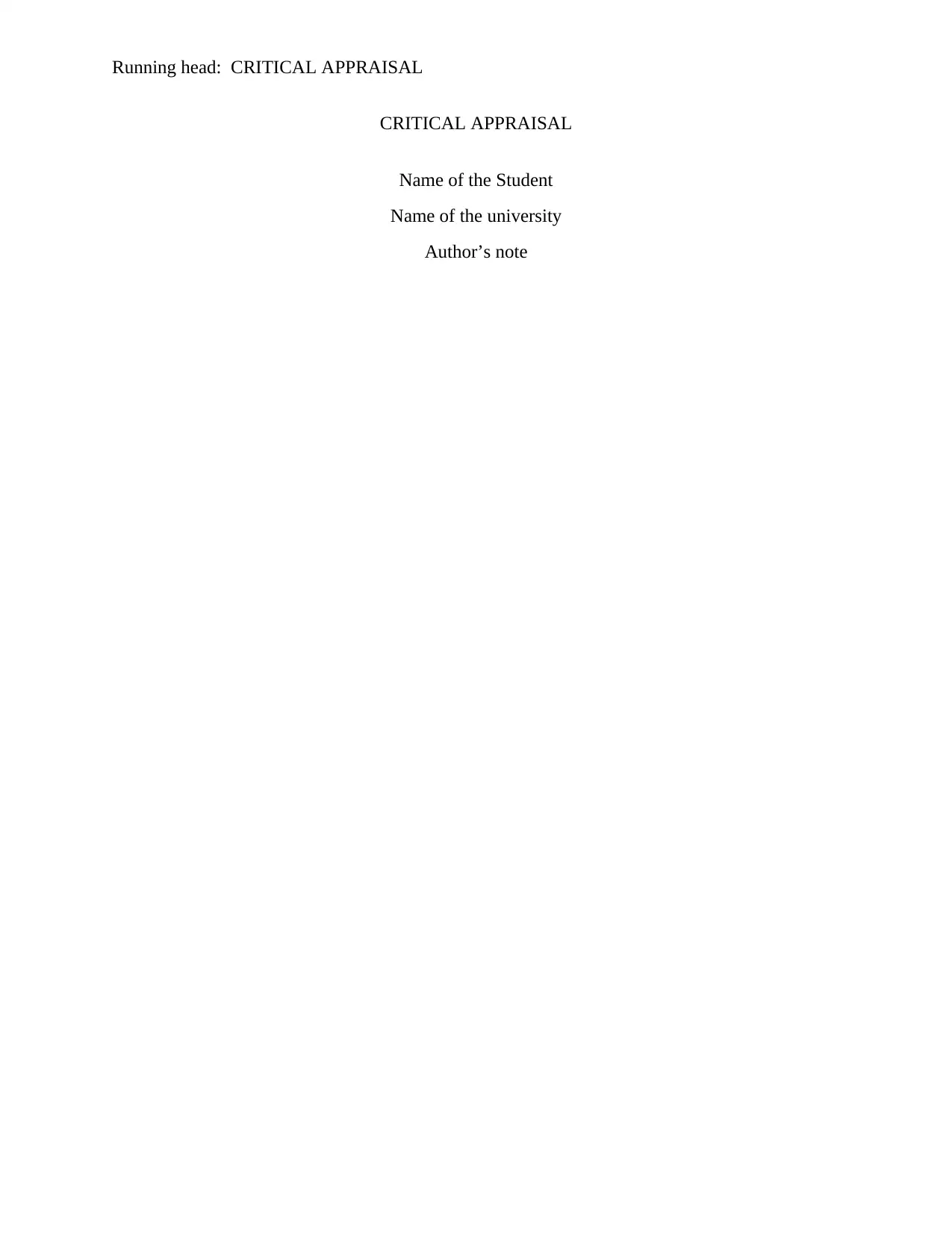
Running head: CRITICAL APPRAISAL
CRITICAL APPRAISAL
Name of the Student
Name of the university
Author’s note
CRITICAL APPRAISAL
Name of the Student
Name of the university
Author’s note
Secure Best Marks with AI Grader
Need help grading? Try our AI Grader for instant feedback on your assignments.

1
CRITICAL APPRAISAL
Template to complete Assessment 2 – Table format
Assessment 2 Tay, J., Luscombe-Marsh,
N. D., Thompson, C. H.,
Noakes, M., Buckley, J. D.,
Wittert, G. A., ... &
Brinkworth, G. D. (2015).
Comparison of low-and
high-carbohydrate diets for
type 2 diabetes management:
a randomized trial. The
American journal of clinical
nutrition, 102(4), 780-790.
Mody, L., Krein, S. L.,
Saint, S., Min, L. C.,
Montoya, A., Lansing, B., ...
& Rye, R. A. (2015). A
targeted infection prevention
intervention in nursing home
residents with indwelling
devices: a randomized
clinical trial. JAMA internal
medicine, 175(5), 714-723.
Population of Interest Obese and overweight
adults with type II diabetes
of 35 to 68 years
Type of population was
high risk nursing home with
urinary catheter, feeding
tube or both.
Inclusion & exclusion
criteria
Inclusion criteria :
Overweight and obese
adults with age group
of 35 to 68 years
BMI ( (in kg/m2) : 26
to 45
Population with type
two diabetes and
taking medications
Exclusion criteria:
impaired renal
function
proteinuria
type 1 diabetes
history of
malignancy;
gastrointestinal
disease
Smoking
history of an
eating disorder
lactation
Inclusion criteria:
Nursing home stays
with an indwelling
urinary catheter or
feeding tube or both
Receiving period is
more than 72 hours
Informed consent
Exclusion criteria :
Residents
receiving end-
of-life care
Sampling Method The study was conducted in
a clinical where the
participants were block
matched for their sex, age,
HbAc1, diabetes medication
and randomly allocated.
The sample included 12
nursing homes where mean
137 beds and the participants
were included after thorough
assessment of wound care
for mean of 22 residents
CRITICAL APPRAISAL
Template to complete Assessment 2 – Table format
Assessment 2 Tay, J., Luscombe-Marsh,
N. D., Thompson, C. H.,
Noakes, M., Buckley, J. D.,
Wittert, G. A., ... &
Brinkworth, G. D. (2015).
Comparison of low-and
high-carbohydrate diets for
type 2 diabetes management:
a randomized trial. The
American journal of clinical
nutrition, 102(4), 780-790.
Mody, L., Krein, S. L.,
Saint, S., Min, L. C.,
Montoya, A., Lansing, B., ...
& Rye, R. A. (2015). A
targeted infection prevention
intervention in nursing home
residents with indwelling
devices: a randomized
clinical trial. JAMA internal
medicine, 175(5), 714-723.
Population of Interest Obese and overweight
adults with type II diabetes
of 35 to 68 years
Type of population was
high risk nursing home with
urinary catheter, feeding
tube or both.
Inclusion & exclusion
criteria
Inclusion criteria :
Overweight and obese
adults with age group
of 35 to 68 years
BMI ( (in kg/m2) : 26
to 45
Population with type
two diabetes and
taking medications
Exclusion criteria:
impaired renal
function
proteinuria
type 1 diabetes
history of
malignancy;
gastrointestinal
disease
Smoking
history of an
eating disorder
lactation
Inclusion criteria:
Nursing home stays
with an indwelling
urinary catheter or
feeding tube or both
Receiving period is
more than 72 hours
Informed consent
Exclusion criteria :
Residents
receiving end-
of-life care
Sampling Method The study was conducted in
a clinical where the
participants were block
matched for their sex, age,
HbAc1, diabetes medication
and randomly allocated.
The sample included 12
nursing homes where mean
137 beds and the participants
were included after thorough
assessment of wound care
for mean of 22 residents

2
CRITICAL APPRAISAL
Hemming et al. (2015),
discussed by block
randomization is commonly
used in clinical trials in order
to reduce the bias as well as
archive balance in
allocation of participants,
especially when sample size
is small.
with per year according to
the inclusion criteria.
The researchers used cluster
randomization for nursing
homes for the study rather
than participant (Toye et al.,
2015). The researchers also
used stratified randomization
for hospital.
Sample size The sample size was obese
and overweight115 adults
The sample size 418 NH
residents with indwelling
34 174 device of device-
days
Allocation Method The participants were
randomly allocated into two
groups. One group was
allocated with low-
carbohydrate, high–
unsaturated fat, low–
saturated fat (LC) (n = 57)
and another group was
allocated with a high-
carbohydrate, low-fat (HC)
diet (n = 58) combined with
high aerobic and resistance
exercise
The nursing home was used
as a unit of allocation and
the nursing home was
stratified by profitable or
non-profitable (Kabaghe et
al., 2015). After
stratification, the allocation
was done by using compute
generated randomizations.
Treatment and Control
Groups
The study has no control
group since the study aimed
to compare between two
diet.
The six nursing home with
participants were
randomized into where 6
were intervention group and
other were control
Type of blinding The study used single
blinding for the study. Krogh
et al. (2016), single blinding
method is used when
participants were unaware of
the treatment.
The double blinding method
was used since the field
staffs were unaware of
intervention assignment.
Rossen et al. (2015), double
blinding is the most common
study where experimenters
and participants were
unaware of intervention.
This kind of study was
useful for preventing the
CRITICAL APPRAISAL
Hemming et al. (2015),
discussed by block
randomization is commonly
used in clinical trials in order
to reduce the bias as well as
archive balance in
allocation of participants,
especially when sample size
is small.
with per year according to
the inclusion criteria.
The researchers used cluster
randomization for nursing
homes for the study rather
than participant (Toye et al.,
2015). The researchers also
used stratified randomization
for hospital.
Sample size The sample size was obese
and overweight115 adults
The sample size 418 NH
residents with indwelling
34 174 device of device-
days
Allocation Method The participants were
randomly allocated into two
groups. One group was
allocated with low-
carbohydrate, high–
unsaturated fat, low–
saturated fat (LC) (n = 57)
and another group was
allocated with a high-
carbohydrate, low-fat (HC)
diet (n = 58) combined with
high aerobic and resistance
exercise
The nursing home was used
as a unit of allocation and
the nursing home was
stratified by profitable or
non-profitable (Kabaghe et
al., 2015). After
stratification, the allocation
was done by using compute
generated randomizations.
Treatment and Control
Groups
The study has no control
group since the study aimed
to compare between two
diet.
The six nursing home with
participants were
randomized into where 6
were intervention group and
other were control
Type of blinding The study used single
blinding for the study. Krogh
et al. (2016), single blinding
method is used when
participants were unaware of
the treatment.
The double blinding method
was used since the field
staffs were unaware of
intervention assignment.
Rossen et al. (2015), double
blinding is the most common
study where experimenters
and participants were
unaware of intervention.
This kind of study was
useful for preventing the
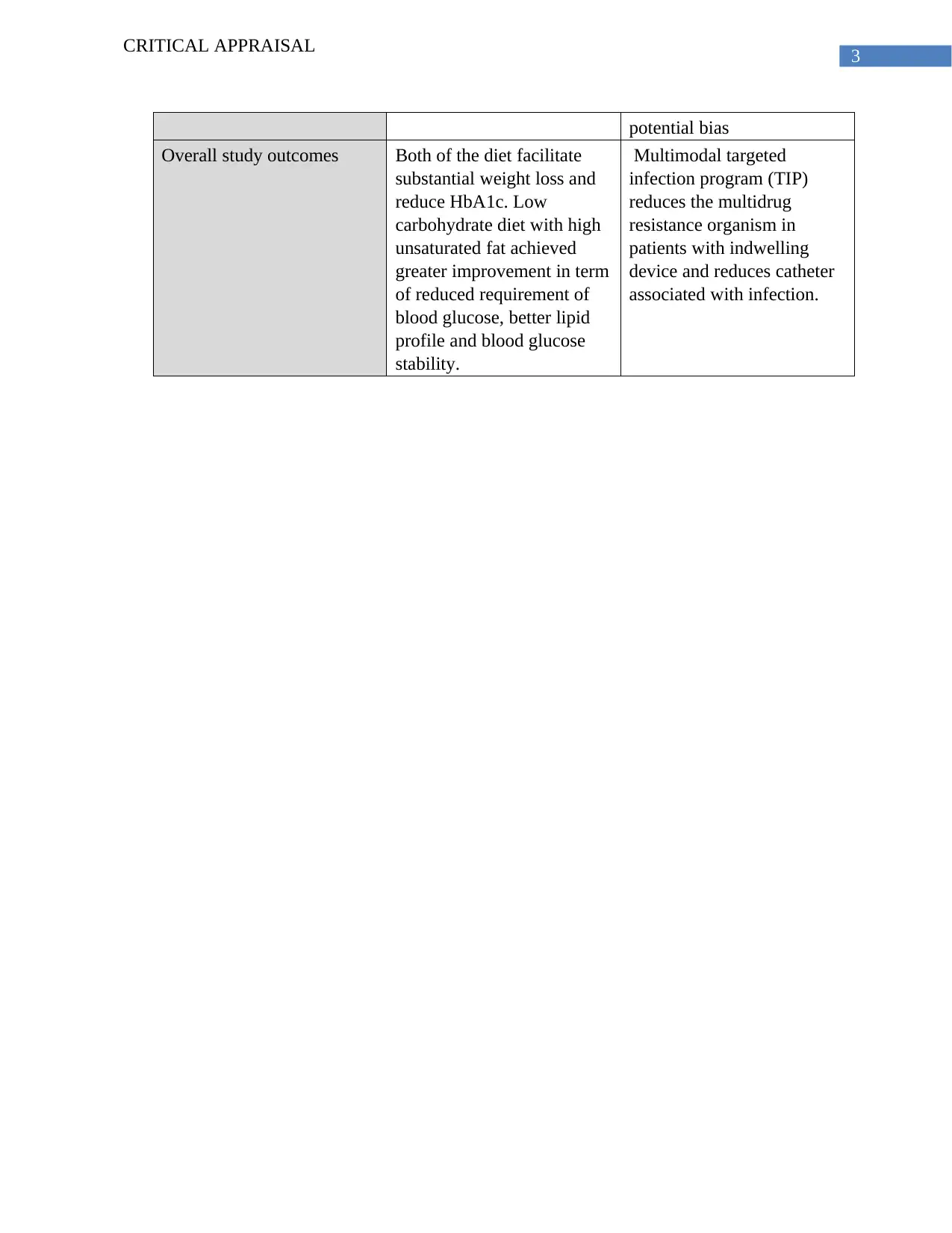
3
CRITICAL APPRAISAL
potential bias
Overall study outcomes Both of the diet facilitate
substantial weight loss and
reduce HbA1c. Low
carbohydrate diet with high
unsaturated fat achieved
greater improvement in term
of reduced requirement of
blood glucose, better lipid
profile and blood glucose
stability.
Multimodal targeted
infection program (TIP)
reduces the multidrug
resistance organism in
patients with indwelling
device and reduces catheter
associated with infection.
CRITICAL APPRAISAL
potential bias
Overall study outcomes Both of the diet facilitate
substantial weight loss and
reduce HbA1c. Low
carbohydrate diet with high
unsaturated fat achieved
greater improvement in term
of reduced requirement of
blood glucose, better lipid
profile and blood glucose
stability.
Multimodal targeted
infection program (TIP)
reduces the multidrug
resistance organism in
patients with indwelling
device and reduces catheter
associated with infection.
Secure Best Marks with AI Grader
Need help grading? Try our AI Grader for instant feedback on your assignments.
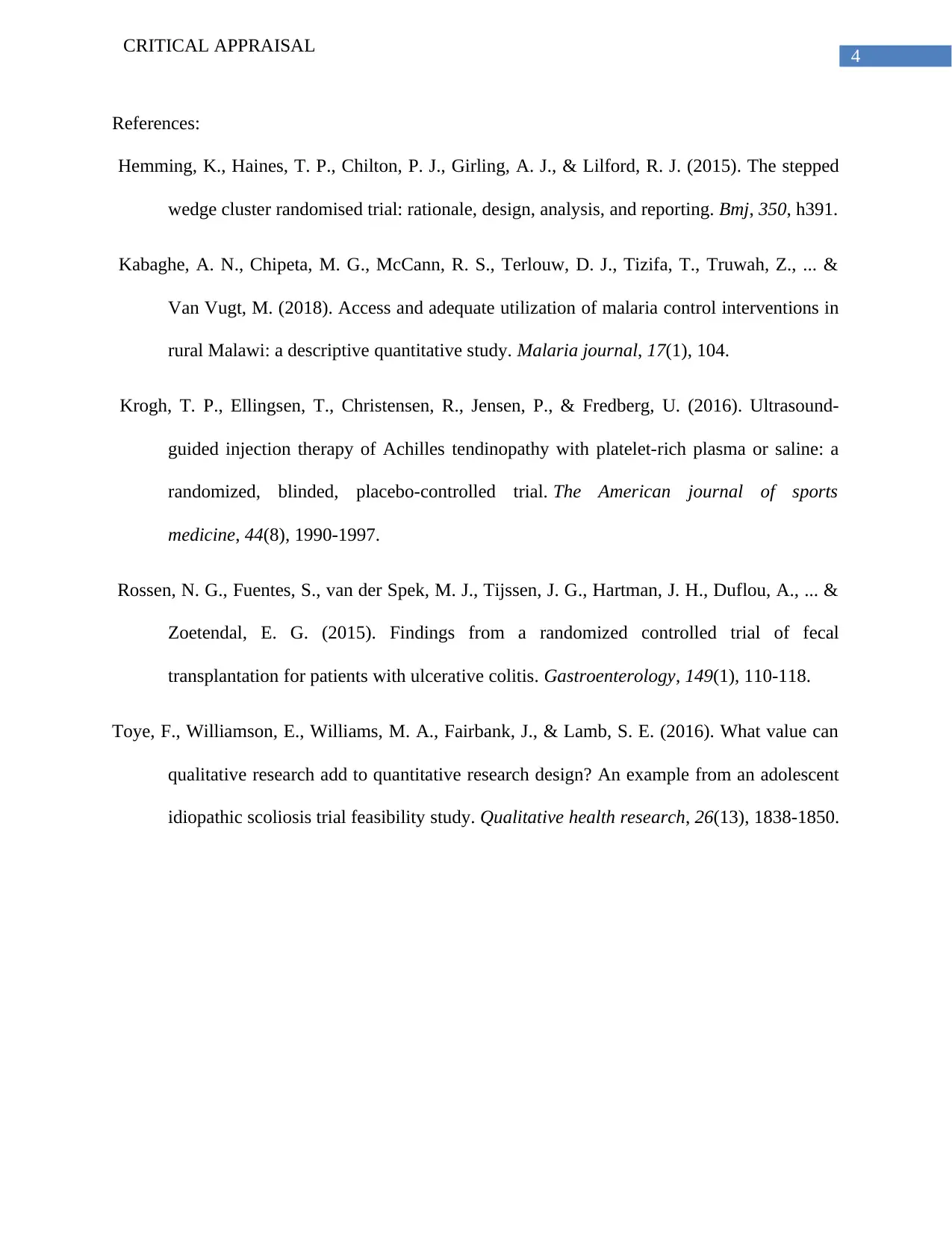
4
CRITICAL APPRAISAL
References:
Hemming, K., Haines, T. P., Chilton, P. J., Girling, A. J., & Lilford, R. J. (2015). The stepped
wedge cluster randomised trial: rationale, design, analysis, and reporting. Bmj, 350, h391.
Kabaghe, A. N., Chipeta, M. G., McCann, R. S., Terlouw, D. J., Tizifa, T., Truwah, Z., ... &
Van Vugt, M. (2018). Access and adequate utilization of malaria control interventions in
rural Malawi: a descriptive quantitative study. Malaria journal, 17(1), 104.
Krogh, T. P., Ellingsen, T., Christensen, R., Jensen, P., & Fredberg, U. (2016). Ultrasound-
guided injection therapy of Achilles tendinopathy with platelet-rich plasma or saline: a
randomized, blinded, placebo-controlled trial. The American journal of sports
medicine, 44(8), 1990-1997.
Rossen, N. G., Fuentes, S., van der Spek, M. J., Tijssen, J. G., Hartman, J. H., Duflou, A., ... &
Zoetendal, E. G. (2015). Findings from a randomized controlled trial of fecal
transplantation for patients with ulcerative colitis. Gastroenterology, 149(1), 110-118.
Toye, F., Williamson, E., Williams, M. A., Fairbank, J., & Lamb, S. E. (2016). What value can
qualitative research add to quantitative research design? An example from an adolescent
idiopathic scoliosis trial feasibility study. Qualitative health research, 26(13), 1838-1850.
CRITICAL APPRAISAL
References:
Hemming, K., Haines, T. P., Chilton, P. J., Girling, A. J., & Lilford, R. J. (2015). The stepped
wedge cluster randomised trial: rationale, design, analysis, and reporting. Bmj, 350, h391.
Kabaghe, A. N., Chipeta, M. G., McCann, R. S., Terlouw, D. J., Tizifa, T., Truwah, Z., ... &
Van Vugt, M. (2018). Access and adequate utilization of malaria control interventions in
rural Malawi: a descriptive quantitative study. Malaria journal, 17(1), 104.
Krogh, T. P., Ellingsen, T., Christensen, R., Jensen, P., & Fredberg, U. (2016). Ultrasound-
guided injection therapy of Achilles tendinopathy with platelet-rich plasma or saline: a
randomized, blinded, placebo-controlled trial. The American journal of sports
medicine, 44(8), 1990-1997.
Rossen, N. G., Fuentes, S., van der Spek, M. J., Tijssen, J. G., Hartman, J. H., Duflou, A., ... &
Zoetendal, E. G. (2015). Findings from a randomized controlled trial of fecal
transplantation for patients with ulcerative colitis. Gastroenterology, 149(1), 110-118.
Toye, F., Williamson, E., Williams, M. A., Fairbank, J., & Lamb, S. E. (2016). What value can
qualitative research add to quantitative research design? An example from an adolescent
idiopathic scoliosis trial feasibility study. Qualitative health research, 26(13), 1838-1850.
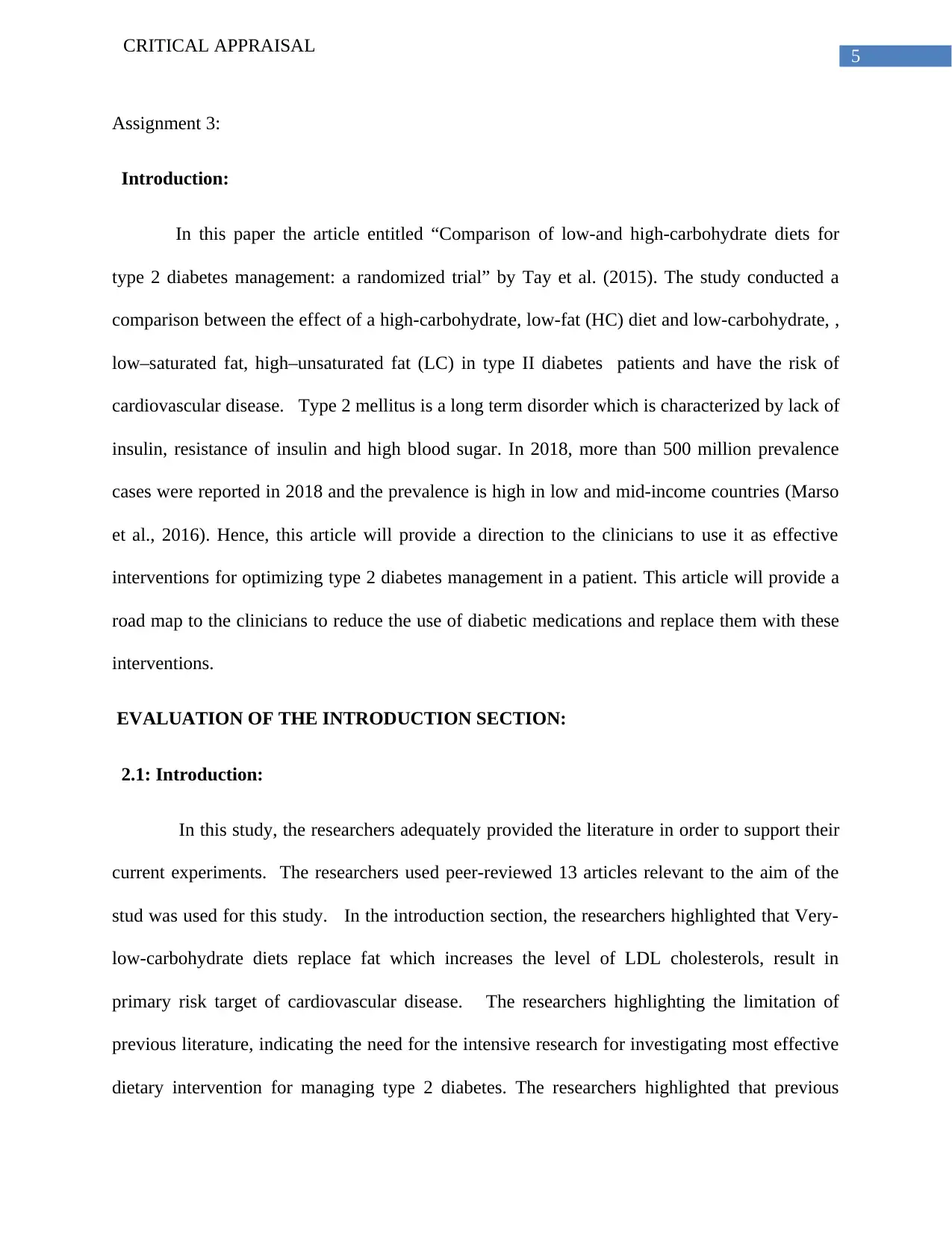
5
CRITICAL APPRAISAL
Assignment 3:
Introduction:
In this paper the article entitled “Comparison of low-and high-carbohydrate diets for
type 2 diabetes management: a randomized trial” by Tay et al. (2015). The study conducted a
comparison between the effect of a high-carbohydrate, low-fat (HC) diet and low-carbohydrate, ,
low–saturated fat, high–unsaturated fat (LC) in type II diabetes patients and have the risk of
cardiovascular disease. Type 2 mellitus is a long term disorder which is characterized by lack of
insulin, resistance of insulin and high blood sugar. In 2018, more than 500 million prevalence
cases were reported in 2018 and the prevalence is high in low and mid-income countries (Marso
et al., 2016). Hence, this article will provide a direction to the clinicians to use it as effective
interventions for optimizing type 2 diabetes management in a patient. This article will provide a
road map to the clinicians to reduce the use of diabetic medications and replace them with these
interventions.
EVALUATION OF THE INTRODUCTION SECTION:
2.1: Introduction:
In this study, the researchers adequately provided the literature in order to support their
current experiments. The researchers used peer-reviewed 13 articles relevant to the aim of the
stud was used for this study. In the introduction section, the researchers highlighted that Very-
low-carbohydrate diets replace fat which increases the level of LDL cholesterols, result in
primary risk target of cardiovascular disease. The researchers highlighting the limitation of
previous literature, indicating the need for the intensive research for investigating most effective
dietary intervention for managing type 2 diabetes. The researchers highlighted that previous
CRITICAL APPRAISAL
Assignment 3:
Introduction:
In this paper the article entitled “Comparison of low-and high-carbohydrate diets for
type 2 diabetes management: a randomized trial” by Tay et al. (2015). The study conducted a
comparison between the effect of a high-carbohydrate, low-fat (HC) diet and low-carbohydrate, ,
low–saturated fat, high–unsaturated fat (LC) in type II diabetes patients and have the risk of
cardiovascular disease. Type 2 mellitus is a long term disorder which is characterized by lack of
insulin, resistance of insulin and high blood sugar. In 2018, more than 500 million prevalence
cases were reported in 2018 and the prevalence is high in low and mid-income countries (Marso
et al., 2016). Hence, this article will provide a direction to the clinicians to use it as effective
interventions for optimizing type 2 diabetes management in a patient. This article will provide a
road map to the clinicians to reduce the use of diabetic medications and replace them with these
interventions.
EVALUATION OF THE INTRODUCTION SECTION:
2.1: Introduction:
In this study, the researchers adequately provided the literature in order to support their
current experiments. The researchers used peer-reviewed 13 articles relevant to the aim of the
stud was used for this study. In the introduction section, the researchers highlighted that Very-
low-carbohydrate diets replace fat which increases the level of LDL cholesterols, result in
primary risk target of cardiovascular disease. The researchers highlighting the limitation of
previous literature, indicating the need for the intensive research for investigating most effective
dietary intervention for managing type 2 diabetes. The researchers highlighted that previous
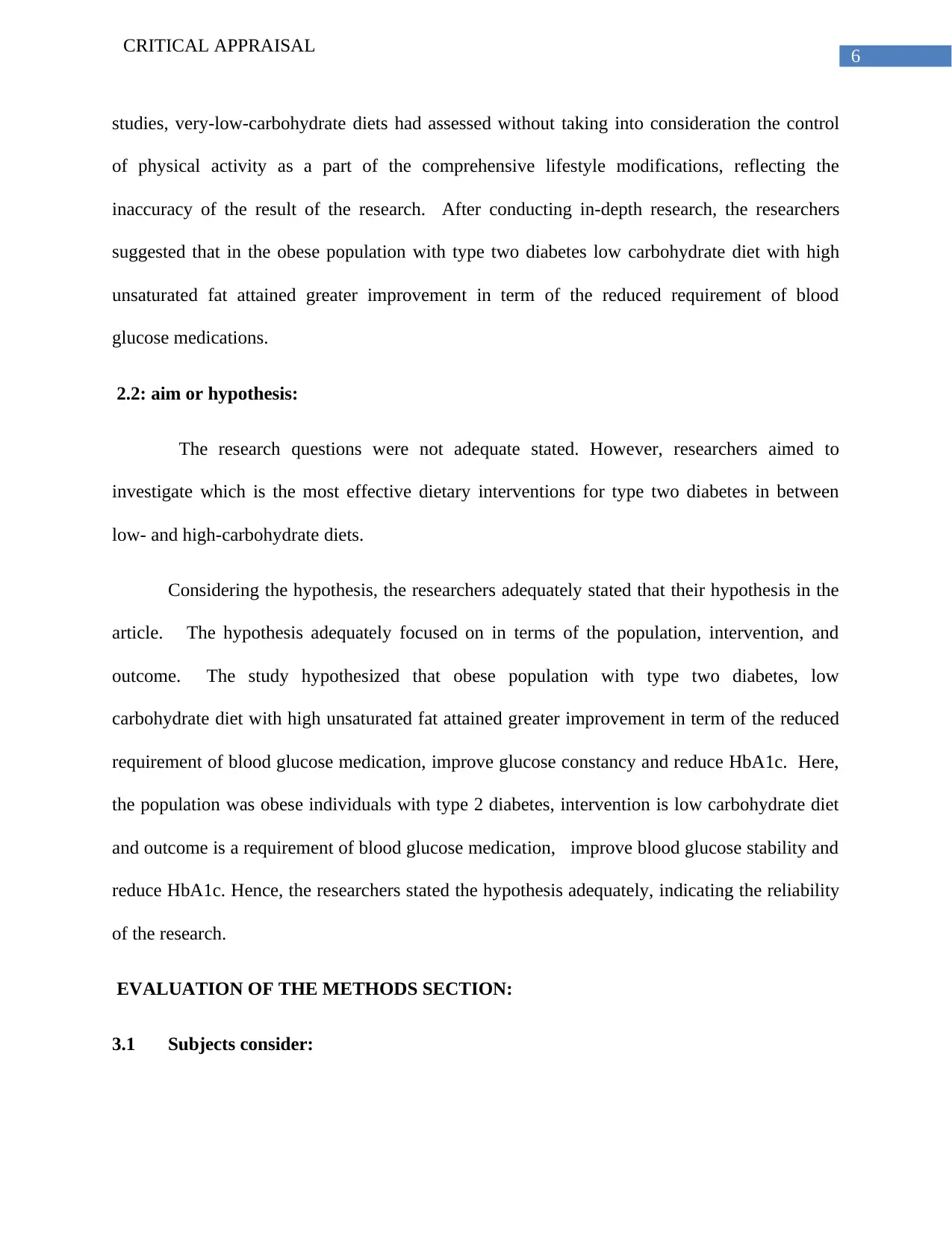
6
CRITICAL APPRAISAL
studies, very-low-carbohydrate diets had assessed without taking into consideration the control
of physical activity as a part of the comprehensive lifestyle modifications, reflecting the
inaccuracy of the result of the research. After conducting in-depth research, the researchers
suggested that in the obese population with type two diabetes low carbohydrate diet with high
unsaturated fat attained greater improvement in term of the reduced requirement of blood
glucose medications.
2.2: aim or hypothesis:
The research questions were not adequate stated. However, researchers aimed to
investigate which is the most effective dietary interventions for type two diabetes in between
low- and high-carbohydrate diets.
Considering the hypothesis, the researchers adequately stated that their hypothesis in the
article. The hypothesis adequately focused on in terms of the population, intervention, and
outcome. The study hypothesized that obese population with type two diabetes, low
carbohydrate diet with high unsaturated fat attained greater improvement in term of the reduced
requirement of blood glucose medication, improve glucose constancy and reduce HbA1c. Here,
the population was obese individuals with type 2 diabetes, intervention is low carbohydrate diet
and outcome is a requirement of blood glucose medication, improve blood glucose stability and
reduce HbA1c. Hence, the researchers stated the hypothesis adequately, indicating the reliability
of the research.
EVALUATION OF THE METHODS SECTION:
3.1 Subjects consider:
CRITICAL APPRAISAL
studies, very-low-carbohydrate diets had assessed without taking into consideration the control
of physical activity as a part of the comprehensive lifestyle modifications, reflecting the
inaccuracy of the result of the research. After conducting in-depth research, the researchers
suggested that in the obese population with type two diabetes low carbohydrate diet with high
unsaturated fat attained greater improvement in term of the reduced requirement of blood
glucose medications.
2.2: aim or hypothesis:
The research questions were not adequate stated. However, researchers aimed to
investigate which is the most effective dietary interventions for type two diabetes in between
low- and high-carbohydrate diets.
Considering the hypothesis, the researchers adequately stated that their hypothesis in the
article. The hypothesis adequately focused on in terms of the population, intervention, and
outcome. The study hypothesized that obese population with type two diabetes, low
carbohydrate diet with high unsaturated fat attained greater improvement in term of the reduced
requirement of blood glucose medication, improve glucose constancy and reduce HbA1c. Here,
the population was obese individuals with type 2 diabetes, intervention is low carbohydrate diet
and outcome is a requirement of blood glucose medication, improve blood glucose stability and
reduce HbA1c. Hence, the researchers stated the hypothesis adequately, indicating the reliability
of the research.
EVALUATION OF THE METHODS SECTION:
3.1 Subjects consider:
Paraphrase This Document
Need a fresh take? Get an instant paraphrase of this document with our AI Paraphraser
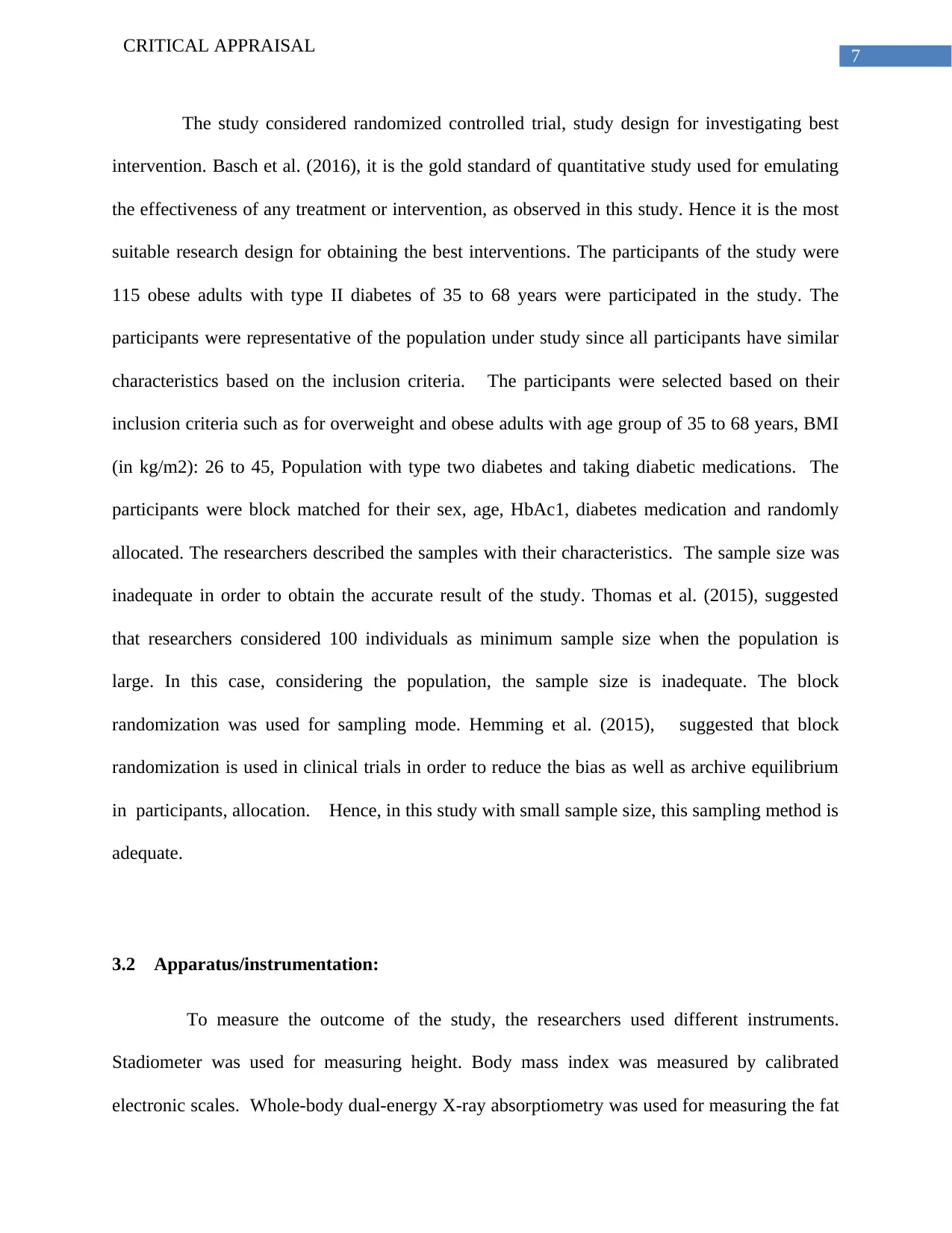
7
CRITICAL APPRAISAL
The study considered randomized controlled trial, study design for investigating best
intervention. Basch et al. (2016), it is the gold standard of quantitative study used for emulating
the effectiveness of any treatment or intervention, as observed in this study. Hence it is the most
suitable research design for obtaining the best interventions. The participants of the study were
115 obese adults with type II diabetes of 35 to 68 years were participated in the study. The
participants were representative of the population under study since all participants have similar
characteristics based on the inclusion criteria. The participants were selected based on their
inclusion criteria such as for overweight and obese adults with age group of 35 to 68 years, BMI
(in kg/m2): 26 to 45, Population with type two diabetes and taking diabetic medications. The
participants were block matched for their sex, age, HbAc1, diabetes medication and randomly
allocated. The researchers described the samples with their characteristics. The sample size was
inadequate in order to obtain the accurate result of the study. Thomas et al. (2015), suggested
that researchers considered 100 individuals as minimum sample size when the population is
large. In this case, considering the population, the sample size is inadequate. The block
randomization was used for sampling mode. Hemming et al. (2015), suggested that block
randomization is used in clinical trials in order to reduce the bias as well as archive equilibrium
in participants, allocation. Hence, in this study with small sample size, this sampling method is
adequate.
3.2 Apparatus/instrumentation:
To measure the outcome of the study, the researchers used different instruments.
Stadiometer was used for measuring height. Body mass index was measured by calibrated
electronic scales. Whole-body dual-energy X-ray absorptiometry was used for measuring the fat
CRITICAL APPRAISAL
The study considered randomized controlled trial, study design for investigating best
intervention. Basch et al. (2016), it is the gold standard of quantitative study used for emulating
the effectiveness of any treatment or intervention, as observed in this study. Hence it is the most
suitable research design for obtaining the best interventions. The participants of the study were
115 obese adults with type II diabetes of 35 to 68 years were participated in the study. The
participants were representative of the population under study since all participants have similar
characteristics based on the inclusion criteria. The participants were selected based on their
inclusion criteria such as for overweight and obese adults with age group of 35 to 68 years, BMI
(in kg/m2): 26 to 45, Population with type two diabetes and taking diabetic medications. The
participants were block matched for their sex, age, HbAc1, diabetes medication and randomly
allocated. The researchers described the samples with their characteristics. The sample size was
inadequate in order to obtain the accurate result of the study. Thomas et al. (2015), suggested
that researchers considered 100 individuals as minimum sample size when the population is
large. In this case, considering the population, the sample size is inadequate. The block
randomization was used for sampling mode. Hemming et al. (2015), suggested that block
randomization is used in clinical trials in order to reduce the bias as well as archive equilibrium
in participants, allocation. Hence, in this study with small sample size, this sampling method is
adequate.
3.2 Apparatus/instrumentation:
To measure the outcome of the study, the researchers used different instruments.
Stadiometer was used for measuring height. Body mass index was measured by calibrated
electronic scales. Whole-body dual-energy X-ray absorptiometry was used for measuring the fat
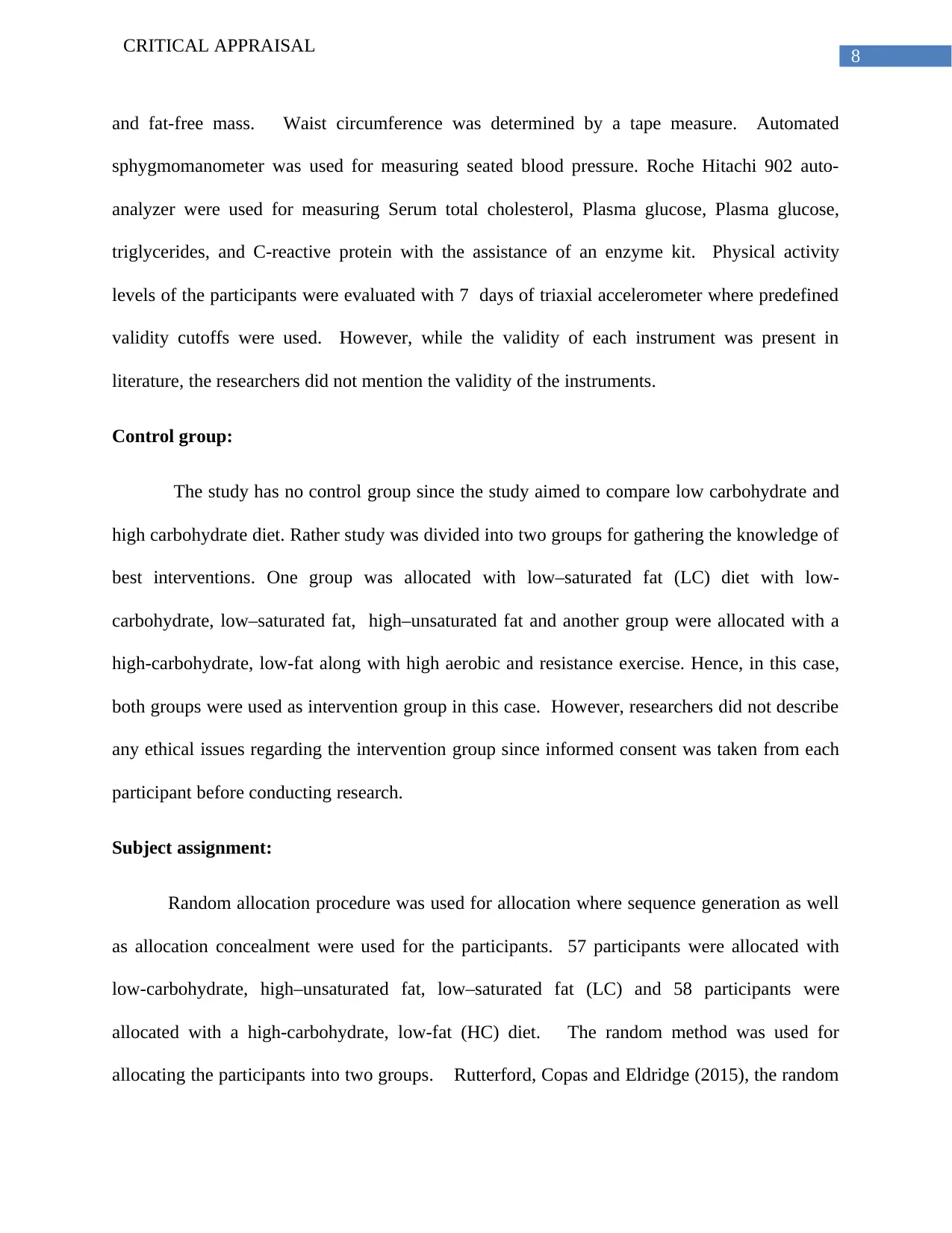
8
CRITICAL APPRAISAL
and fat-free mass. Waist circumference was determined by a tape measure. Automated
sphygmomanometer was used for measuring seated blood pressure. Roche Hitachi 902 auto-
analyzer were used for measuring Serum total cholesterol, Plasma glucose, Plasma glucose,
triglycerides, and C-reactive protein with the assistance of an enzyme kit. Physical activity
levels of the participants were evaluated with 7 days of triaxial accelerometer where predefined
validity cutoffs were used. However, while the validity of each instrument was present in
literature, the researchers did not mention the validity of the instruments.
Control group:
The study has no control group since the study aimed to compare low carbohydrate and
high carbohydrate diet. Rather study was divided into two groups for gathering the knowledge of
best interventions. One group was allocated with low–saturated fat (LC) diet with low-
carbohydrate, low–saturated fat, high–unsaturated fat and another group were allocated with a
high-carbohydrate, low-fat along with high aerobic and resistance exercise. Hence, in this case,
both groups were used as intervention group in this case. However, researchers did not describe
any ethical issues regarding the intervention group since informed consent was taken from each
participant before conducting research.
Subject assignment:
Random allocation procedure was used for allocation where sequence generation as well
as allocation concealment were used for the participants. 57 participants were allocated with
low-carbohydrate, high–unsaturated fat, low–saturated fat (LC) and 58 participants were
allocated with a high-carbohydrate, low-fat (HC) diet. The random method was used for
allocating the participants into two groups. Rutterford, Copas and Eldridge (2015), the random
CRITICAL APPRAISAL
and fat-free mass. Waist circumference was determined by a tape measure. Automated
sphygmomanometer was used for measuring seated blood pressure. Roche Hitachi 902 auto-
analyzer were used for measuring Serum total cholesterol, Plasma glucose, Plasma glucose,
triglycerides, and C-reactive protein with the assistance of an enzyme kit. Physical activity
levels of the participants were evaluated with 7 days of triaxial accelerometer where predefined
validity cutoffs were used. However, while the validity of each instrument was present in
literature, the researchers did not mention the validity of the instruments.
Control group:
The study has no control group since the study aimed to compare low carbohydrate and
high carbohydrate diet. Rather study was divided into two groups for gathering the knowledge of
best interventions. One group was allocated with low–saturated fat (LC) diet with low-
carbohydrate, low–saturated fat, high–unsaturated fat and another group were allocated with a
high-carbohydrate, low-fat along with high aerobic and resistance exercise. Hence, in this case,
both groups were used as intervention group in this case. However, researchers did not describe
any ethical issues regarding the intervention group since informed consent was taken from each
participant before conducting research.
Subject assignment:
Random allocation procedure was used for allocation where sequence generation as well
as allocation concealment were used for the participants. 57 participants were allocated with
low-carbohydrate, high–unsaturated fat, low–saturated fat (LC) and 58 participants were
allocated with a high-carbohydrate, low-fat (HC) diet. The random method was used for
allocating the participants into two groups. Rutterford, Copas and Eldridge (2015), the random
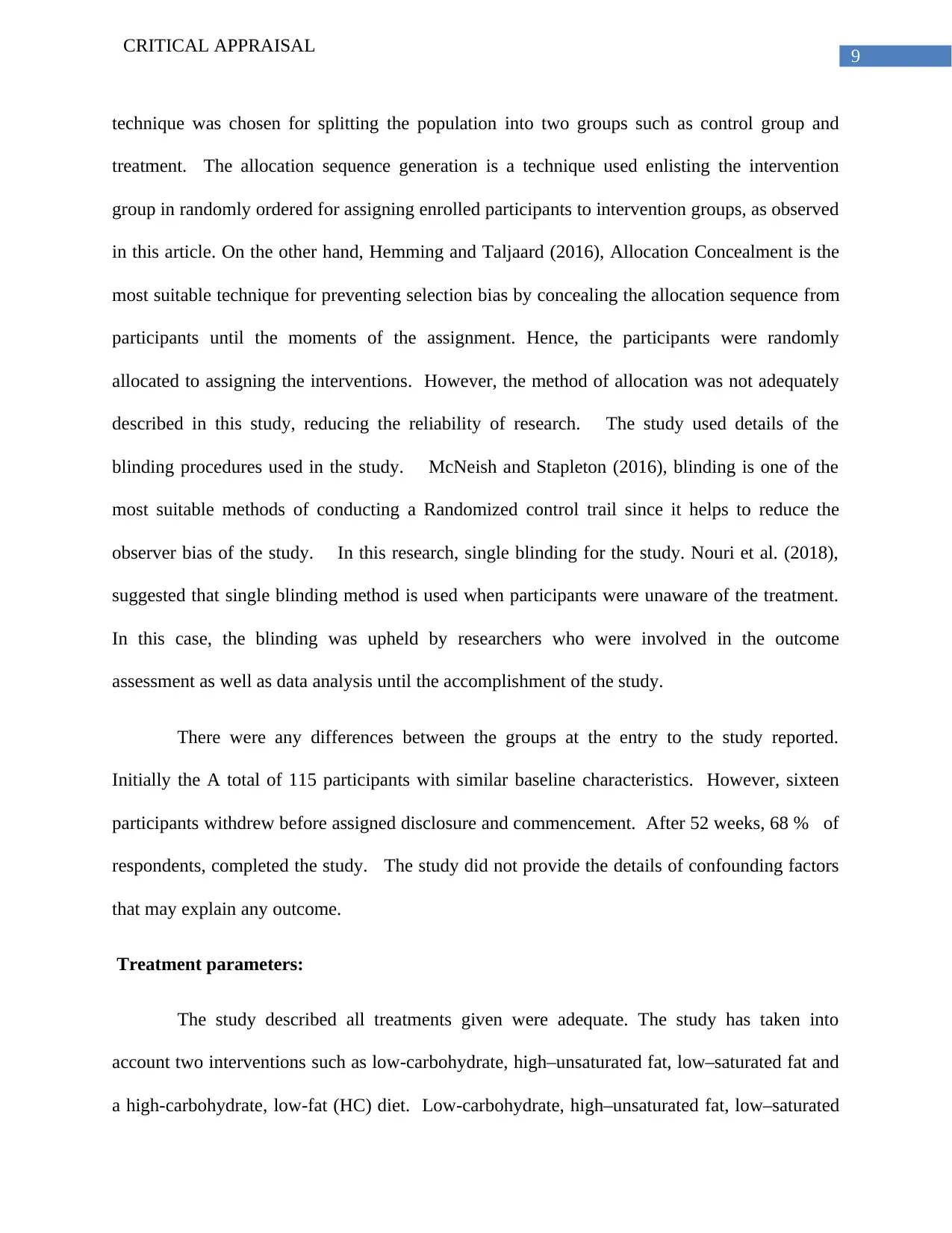
9
CRITICAL APPRAISAL
technique was chosen for splitting the population into two groups such as control group and
treatment. The allocation sequence generation is a technique used enlisting the intervention
group in randomly ordered for assigning enrolled participants to intervention groups, as observed
in this article. On the other hand, Hemming and Taljaard (2016), Allocation Concealment is the
most suitable technique for preventing selection bias by concealing the allocation sequence from
participants until the moments of the assignment. Hence, the participants were randomly
allocated to assigning the interventions. However, the method of allocation was not adequately
described in this study, reducing the reliability of research. The study used details of the
blinding procedures used in the study. McNeish and Stapleton (2016), blinding is one of the
most suitable methods of conducting a Randomized control trail since it helps to reduce the
observer bias of the study. In this research, single blinding for the study. Nouri et al. (2018),
suggested that single blinding method is used when participants were unaware of the treatment.
In this case, the blinding was upheld by researchers who were involved in the outcome
assessment as well as data analysis until the accomplishment of the study.
There were any differences between the groups at the entry to the study reported.
Initially the A total of 115 participants with similar baseline characteristics. However, sixteen
participants withdrew before assigned disclosure and commencement. After 52 weeks, 68 % of
respondents, completed the study. The study did not provide the details of confounding factors
that may explain any outcome.
Treatment parameters:
The study described all treatments given were adequate. The study has taken into
account two interventions such as low-carbohydrate, high–unsaturated fat, low–saturated fat and
a high-carbohydrate, low-fat (HC) diet. Low-carbohydrate, high–unsaturated fat, low–saturated
CRITICAL APPRAISAL
technique was chosen for splitting the population into two groups such as control group and
treatment. The allocation sequence generation is a technique used enlisting the intervention
group in randomly ordered for assigning enrolled participants to intervention groups, as observed
in this article. On the other hand, Hemming and Taljaard (2016), Allocation Concealment is the
most suitable technique for preventing selection bias by concealing the allocation sequence from
participants until the moments of the assignment. Hence, the participants were randomly
allocated to assigning the interventions. However, the method of allocation was not adequately
described in this study, reducing the reliability of research. The study used details of the
blinding procedures used in the study. McNeish and Stapleton (2016), blinding is one of the
most suitable methods of conducting a Randomized control trail since it helps to reduce the
observer bias of the study. In this research, single blinding for the study. Nouri et al. (2018),
suggested that single blinding method is used when participants were unaware of the treatment.
In this case, the blinding was upheld by researchers who were involved in the outcome
assessment as well as data analysis until the accomplishment of the study.
There were any differences between the groups at the entry to the study reported.
Initially the A total of 115 participants with similar baseline characteristics. However, sixteen
participants withdrew before assigned disclosure and commencement. After 52 weeks, 68 % of
respondents, completed the study. The study did not provide the details of confounding factors
that may explain any outcome.
Treatment parameters:
The study described all treatments given were adequate. The study has taken into
account two interventions such as low-carbohydrate, high–unsaturated fat, low–saturated fat and
a high-carbohydrate, low-fat (HC) diet. Low-carbohydrate, high–unsaturated fat, low–saturated
Secure Best Marks with AI Grader
Need help grading? Try our AI Grader for instant feedback on your assignments.
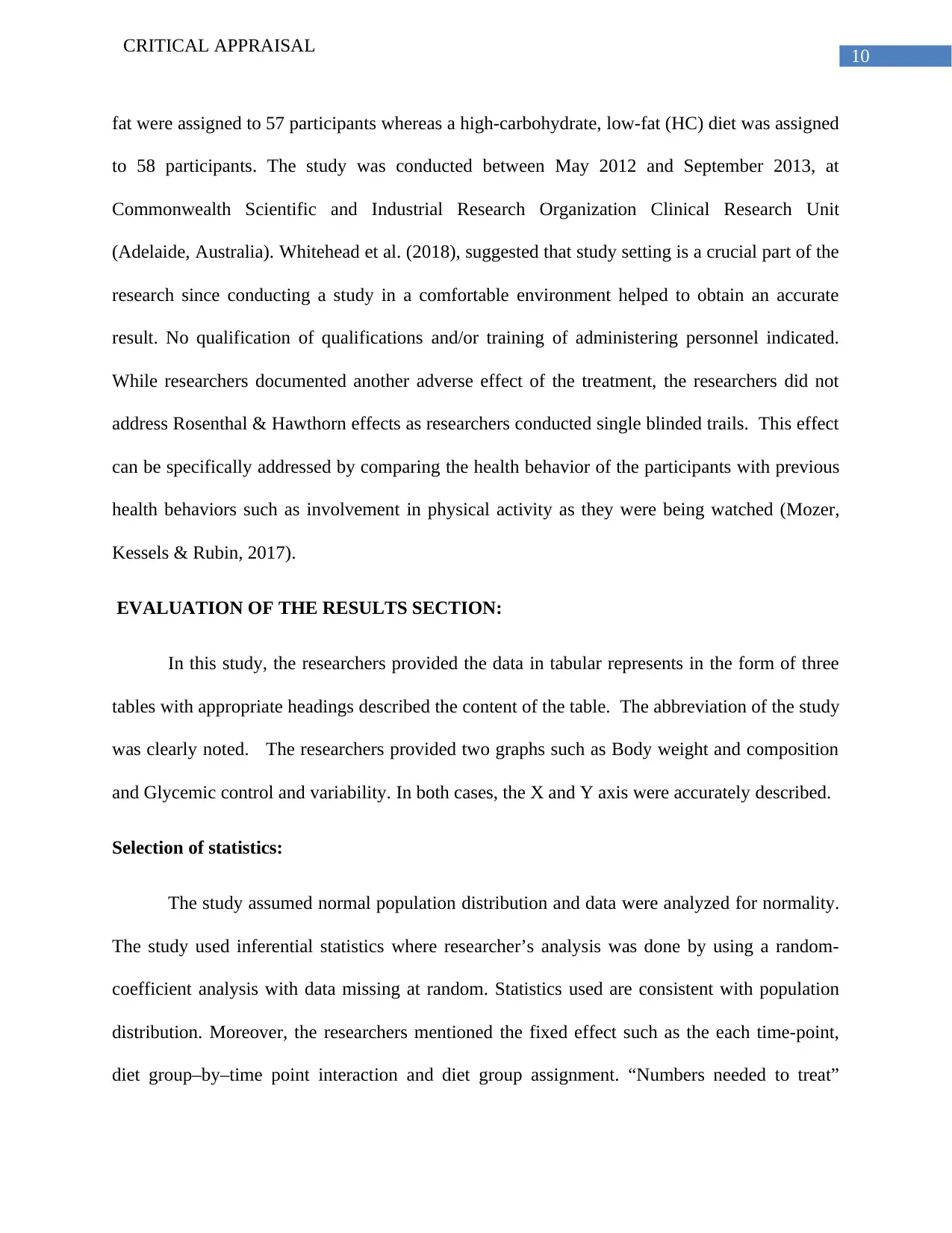
10
CRITICAL APPRAISAL
fat were assigned to 57 participants whereas a high-carbohydrate, low-fat (HC) diet was assigned
to 58 participants. The study was conducted between May 2012 and September 2013, at
Commonwealth Scientific and Industrial Research Organization Clinical Research Unit
(Adelaide, Australia). Whitehead et al. (2018), suggested that study setting is a crucial part of the
research since conducting a study in a comfortable environment helped to obtain an accurate
result. No qualification of qualifications and/or training of administering personnel indicated.
While researchers documented another adverse effect of the treatment, the researchers did not
address Rosenthal & Hawthorn effects as researchers conducted single blinded trails. This effect
can be specifically addressed by comparing the health behavior of the participants with previous
health behaviors such as involvement in physical activity as they were being watched (Mozer,
Kessels & Rubin, 2017).
EVALUATION OF THE RESULTS SECTION:
In this study, the researchers provided the data in tabular represents in the form of three
tables with appropriate headings described the content of the table. The abbreviation of the study
was clearly noted. The researchers provided two graphs such as Body weight and composition
and Glycemic control and variability. In both cases, the X and Y axis were accurately described.
Selection of statistics:
The study assumed normal population distribution and data were analyzed for normality.
The study used inferential statistics where researcher’s analysis was done by using a random-
coefficient analysis with data missing at random. Statistics used are consistent with population
distribution. Moreover, the researchers mentioned the fixed effect such as the each time-point,
diet group–by–time point interaction and diet group assignment. “Numbers needed to treat”
CRITICAL APPRAISAL
fat were assigned to 57 participants whereas a high-carbohydrate, low-fat (HC) diet was assigned
to 58 participants. The study was conducted between May 2012 and September 2013, at
Commonwealth Scientific and Industrial Research Organization Clinical Research Unit
(Adelaide, Australia). Whitehead et al. (2018), suggested that study setting is a crucial part of the
research since conducting a study in a comfortable environment helped to obtain an accurate
result. No qualification of qualifications and/or training of administering personnel indicated.
While researchers documented another adverse effect of the treatment, the researchers did not
address Rosenthal & Hawthorn effects as researchers conducted single blinded trails. This effect
can be specifically addressed by comparing the health behavior of the participants with previous
health behaviors such as involvement in physical activity as they were being watched (Mozer,
Kessels & Rubin, 2017).
EVALUATION OF THE RESULTS SECTION:
In this study, the researchers provided the data in tabular represents in the form of three
tables with appropriate headings described the content of the table. The abbreviation of the study
was clearly noted. The researchers provided two graphs such as Body weight and composition
and Glycemic control and variability. In both cases, the X and Y axis were accurately described.
Selection of statistics:
The study assumed normal population distribution and data were analyzed for normality.
The study used inferential statistics where researcher’s analysis was done by using a random-
coefficient analysis with data missing at random. Statistics used are consistent with population
distribution. Moreover, the researchers mentioned the fixed effect such as the each time-point,
diet group–by–time point interaction and diet group assignment. “Numbers needed to treat”
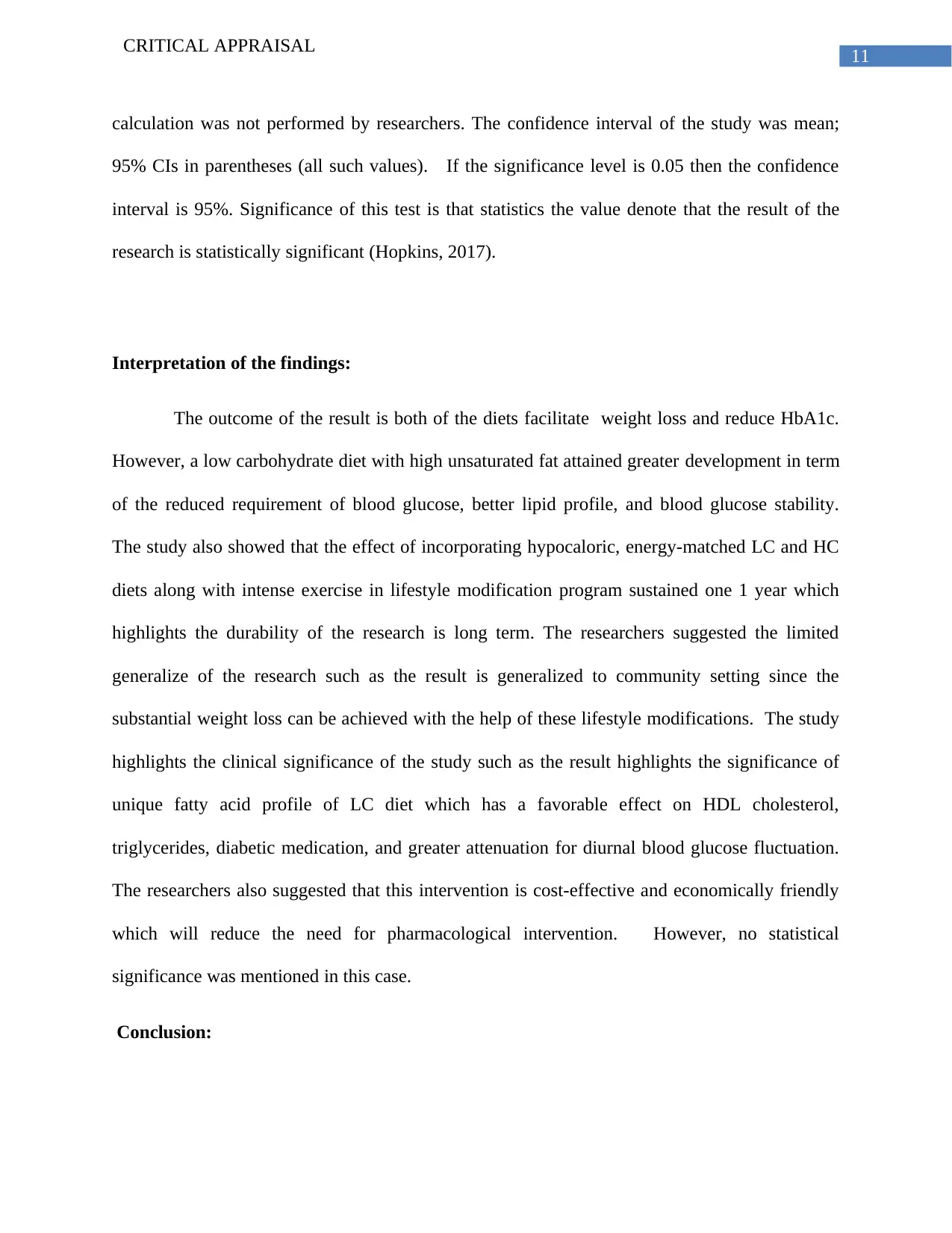
11
CRITICAL APPRAISAL
calculation was not performed by researchers. The confidence interval of the study was mean;
95% CIs in parentheses (all such values). If the significance level is 0.05 then the confidence
interval is 95%. Significance of this test is that statistics the value denote that the result of the
research is statistically significant (Hopkins, 2017).
Interpretation of the findings:
The outcome of the result is both of the diets facilitate weight loss and reduce HbA1c.
However, a low carbohydrate diet with high unsaturated fat attained greater development in term
of the reduced requirement of blood glucose, better lipid profile, and blood glucose stability.
The study also showed that the effect of incorporating hypocaloric, energy-matched LC and HC
diets along with intense exercise in lifestyle modification program sustained one 1 year which
highlights the durability of the research is long term. The researchers suggested the limited
generalize of the research such as the result is generalized to community setting since the
substantial weight loss can be achieved with the help of these lifestyle modifications. The study
highlights the clinical significance of the study such as the result highlights the significance of
unique fatty acid profile of LC diet which has a favorable effect on HDL cholesterol,
triglycerides, diabetic medication, and greater attenuation for diurnal blood glucose fluctuation.
The researchers also suggested that this intervention is cost-effective and economically friendly
which will reduce the need for pharmacological intervention. However, no statistical
significance was mentioned in this case.
Conclusion:
CRITICAL APPRAISAL
calculation was not performed by researchers. The confidence interval of the study was mean;
95% CIs in parentheses (all such values). If the significance level is 0.05 then the confidence
interval is 95%. Significance of this test is that statistics the value denote that the result of the
research is statistically significant (Hopkins, 2017).
Interpretation of the findings:
The outcome of the result is both of the diets facilitate weight loss and reduce HbA1c.
However, a low carbohydrate diet with high unsaturated fat attained greater development in term
of the reduced requirement of blood glucose, better lipid profile, and blood glucose stability.
The study also showed that the effect of incorporating hypocaloric, energy-matched LC and HC
diets along with intense exercise in lifestyle modification program sustained one 1 year which
highlights the durability of the research is long term. The researchers suggested the limited
generalize of the research such as the result is generalized to community setting since the
substantial weight loss can be achieved with the help of these lifestyle modifications. The study
highlights the clinical significance of the study such as the result highlights the significance of
unique fatty acid profile of LC diet which has a favorable effect on HDL cholesterol,
triglycerides, diabetic medication, and greater attenuation for diurnal blood glucose fluctuation.
The researchers also suggested that this intervention is cost-effective and economically friendly
which will reduce the need for pharmacological intervention. However, no statistical
significance was mentioned in this case.
Conclusion:

12
CRITICAL APPRAISAL
Considering the internal validity of the study, the random assignment is central to
internal validity. In this research random assignment of the treatment was done which allowed
the researchers to make causal claims about the effect of the treatment. Hence, the study is
internally valid. On the other hand, considering the external validity, random selection is
essential to the external validity of the study. In this case, selection bias is present as the
selection was done according to the inclusion criteria. Hence, the study is externally invalid. The
strength of the study is that the study conducted a randomized controlled trial, which is the gold
standard of quantitative study used for emulating the effectiveness of any treatment or
intervention, as observed in this study. The limitation of the study is that the research has
selection bias and limited generalization.
CRITICAL APPRAISAL
Considering the internal validity of the study, the random assignment is central to
internal validity. In this research random assignment of the treatment was done which allowed
the researchers to make causal claims about the effect of the treatment. Hence, the study is
internally valid. On the other hand, considering the external validity, random selection is
essential to the external validity of the study. In this case, selection bias is present as the
selection was done according to the inclusion criteria. Hence, the study is externally invalid. The
strength of the study is that the study conducted a randomized controlled trial, which is the gold
standard of quantitative study used for emulating the effectiveness of any treatment or
intervention, as observed in this study. The limitation of the study is that the research has
selection bias and limited generalization.
Paraphrase This Document
Need a fresh take? Get an instant paraphrase of this document with our AI Paraphraser

13
CRITICAL APPRAISAL
References:
Basch, E., Deal, A. M., Kris, M. G., Scher, H. I., Hudis, C. A., Sabbatini, P., ... & Chou, J. F.
(2016). Symptom monitoring with patient-reported outcomes during routine cancer
treatment: a randomized controlled trial. Journal of Clinical Oncology, 34(6), 557.
Hemming, K., & Taljaard, M. (2016). Sample size calculations for stepped wedge and cluster
randomised trials: a unified approach. Journal of clinical epidemiology, 69, 137-146.
Hemming, K., Haines, T. P., Chilton, P. J., Girling, A. J., & Lilford, R. J. (2015). The stepped
wedge cluster randomised trial: rationale, design, analysis, and reporting. Bmj, 350, h391.
Hopkins, W. G. (2017). A Spreadsheet for Deriving a Confidence Interval, Mechanistic
Inference and Clinical Inference from a P Value. Sportscience, 21.
Marso, S. P., Daniels, G. H., Brown-Frandsen, K., Kristensen, P., Mann, J. F., Nauck, M. A., ...
& Steinberg, W. M. (2016). Liraglutide and cardiovascular outcomes in type 2
diabetes. New England Journal of Medicine, 375(4), 311-322.
McNeish, D. M., & Stapleton, L. M. (2016). The effect of small sample size on two-level model
estimates: A review and illustration. Educational Psychology Review, 28(2), 295-314.
Mozer, R., Kessels, R., & Rubin, D. B. (2017, July). Disentangling Treatment and Placebo
Effects in Randomized Experiments Using Principal Stratification—An Introduction.
In The Annual Meeting of the Psychometric Society (pp. 11-23). Springer, Cham.
CRITICAL APPRAISAL
References:
Basch, E., Deal, A. M., Kris, M. G., Scher, H. I., Hudis, C. A., Sabbatini, P., ... & Chou, J. F.
(2016). Symptom monitoring with patient-reported outcomes during routine cancer
treatment: a randomized controlled trial. Journal of Clinical Oncology, 34(6), 557.
Hemming, K., & Taljaard, M. (2016). Sample size calculations for stepped wedge and cluster
randomised trials: a unified approach. Journal of clinical epidemiology, 69, 137-146.
Hemming, K., Haines, T. P., Chilton, P. J., Girling, A. J., & Lilford, R. J. (2015). The stepped
wedge cluster randomised trial: rationale, design, analysis, and reporting. Bmj, 350, h391.
Hopkins, W. G. (2017). A Spreadsheet for Deriving a Confidence Interval, Mechanistic
Inference and Clinical Inference from a P Value. Sportscience, 21.
Marso, S. P., Daniels, G. H., Brown-Frandsen, K., Kristensen, P., Mann, J. F., Nauck, M. A., ...
& Steinberg, W. M. (2016). Liraglutide and cardiovascular outcomes in type 2
diabetes. New England Journal of Medicine, 375(4), 311-322.
McNeish, D. M., & Stapleton, L. M. (2016). The effect of small sample size on two-level model
estimates: A review and illustration. Educational Psychology Review, 28(2), 295-314.
Mozer, R., Kessels, R., & Rubin, D. B. (2017, July). Disentangling Treatment and Placebo
Effects in Randomized Experiments Using Principal Stratification—An Introduction.
In The Annual Meeting of the Psychometric Society (pp. 11-23). Springer, Cham.
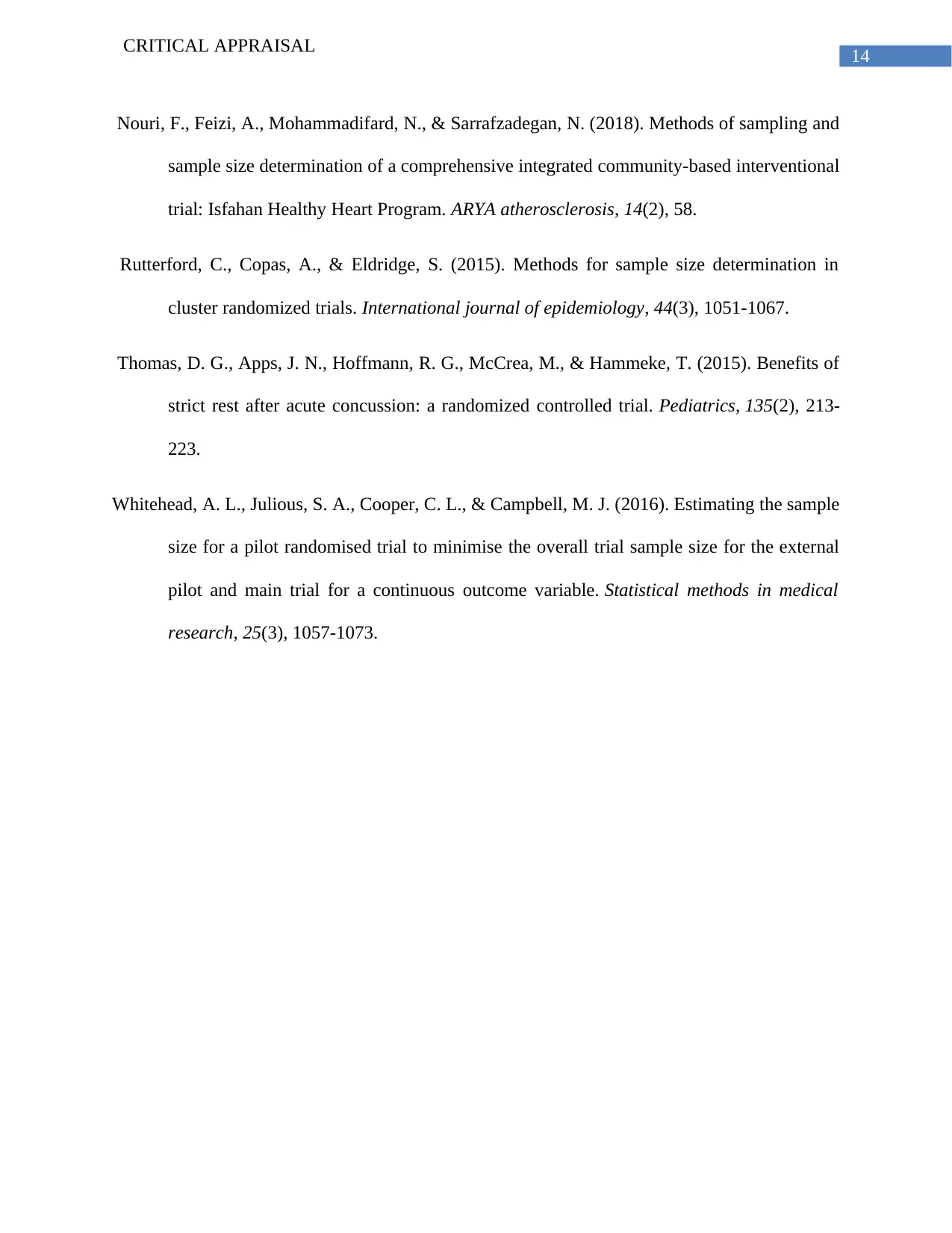
14
CRITICAL APPRAISAL
Nouri, F., Feizi, A., Mohammadifard, N., & Sarrafzadegan, N. (2018). Methods of sampling and
sample size determination of a comprehensive integrated community-based interventional
trial: Isfahan Healthy Heart Program. ARYA atherosclerosis, 14(2), 58.
Rutterford, C., Copas, A., & Eldridge, S. (2015). Methods for sample size determination in
cluster randomized trials. International journal of epidemiology, 44(3), 1051-1067.
Thomas, D. G., Apps, J. N., Hoffmann, R. G., McCrea, M., & Hammeke, T. (2015). Benefits of
strict rest after acute concussion: a randomized controlled trial. Pediatrics, 135(2), 213-
223.
Whitehead, A. L., Julious, S. A., Cooper, C. L., & Campbell, M. J. (2016). Estimating the sample
size for a pilot randomised trial to minimise the overall trial sample size for the external
pilot and main trial for a continuous outcome variable. Statistical methods in medical
research, 25(3), 1057-1073.
CRITICAL APPRAISAL
Nouri, F., Feizi, A., Mohammadifard, N., & Sarrafzadegan, N. (2018). Methods of sampling and
sample size determination of a comprehensive integrated community-based interventional
trial: Isfahan Healthy Heart Program. ARYA atherosclerosis, 14(2), 58.
Rutterford, C., Copas, A., & Eldridge, S. (2015). Methods for sample size determination in
cluster randomized trials. International journal of epidemiology, 44(3), 1051-1067.
Thomas, D. G., Apps, J. N., Hoffmann, R. G., McCrea, M., & Hammeke, T. (2015). Benefits of
strict rest after acute concussion: a randomized controlled trial. Pediatrics, 135(2), 213-
223.
Whitehead, A. L., Julious, S. A., Cooper, C. L., & Campbell, M. J. (2016). Estimating the sample
size for a pilot randomised trial to minimise the overall trial sample size for the external
pilot and main trial for a continuous outcome variable. Statistical methods in medical
research, 25(3), 1057-1073.
1 out of 15
Related Documents
Your All-in-One AI-Powered Toolkit for Academic Success.
+13062052269
info@desklib.com
Available 24*7 on WhatsApp / Email
![[object Object]](/_next/static/media/star-bottom.7253800d.svg)
Unlock your academic potential
© 2024 | Zucol Services PVT LTD | All rights reserved.





